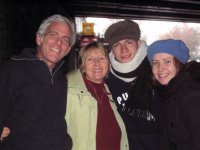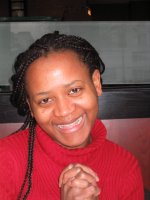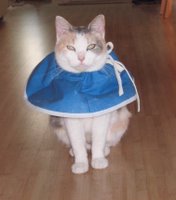On Science and Engineering… and the Spleen that Devoured ClevelandOne of my favorite college professors, Dr. Jon Liebman, once explained the difference between science and engineering like this. Scientists, he said, ask questions of the form, “If I do X, what will happen?”, while engineers ask, “If I want Y to happen, what should I do?” This is one of those profound truths that can take decades to fully absorb, and perhaps I am still working on it. I am thinking about it because I realize a great doctor, like my oncologist Dr. Roger Shiffman, needs to have a lot of engineer in him.
An important distinction between scientists and engineers is the standard of verification to which they must hold their assertions. A scientist needs to have repeated, irrefutable evidence of exactly what happens when she does X before claiming to know the answer. In contrast, an engineer can not always wait for the incontrovertible truth to emerge before he makes an informed decision on the best way to try to make Y happen. Good engineers pay attention to what the scientists have learned and incorporate this knowledge into their thinking, but sometimes they need to try to make Y happen before the science is known.
So it is with Roger. No one seems to know why my spleen is so enormous. No one can scientifically describe exactly why it is soaking up platelets, thereby compromising my ability to accept chemotherapy. In fact, it is a mystery as to why only the platelets are severely deficient. Why isn’t the spleen gobbling up red and white blood cells as voraciously as it devours platelets? Roger can’t just sit around and wait for medical science to catch up with my needs. He needs to make an informed decision today on what to do about it. On his advice and with my niece Jessica’s concurrence, I have agreed to an operation to remove my spleen.
A Hot Date on Valentine’s DayMy surgery will be performed locally by Dr. Mark Vierra, who recently moved to Monterey from Stanford. He is reputedly a major hotshot, whom the Monterey medical community is thrilled to have snagged from the Stanford Medical School faculty. My interview with Dr. Vierra lasted an hour. For fifty-nine minutes, he spewed medical knowledge that gave me a great deal of confidence. Dr. Vierra’s most significant point was that, in the “surgical lore,” as he put it, large spleens are considered hard to remove, but he is very experienced with them and knows the “right tricks.” In the last minute of my appointment, his eyes softened and he said he was really sorry that I had to go through this. It was an understated but impressive display of compassion.
Dr. Vierra is very confident (not that I ever met a timid surgeon). He says that the incision will be larger and more uncomfortable than the one I got for the colon. So, I expect I will be doped up on narcotics again, which means some days of glorious lucidity and some days of down-right stupidity. When the spleen comes out, it will be studied by pathologists, but we may never know what caused it to grow so large. There does not appear to be another cancer causing it, because bone marrow and other tests have come up negative.
The splenectomy is scheduled for February 14th at the Community Hospital of the Monterey Peninsula (CHOMP). Just call me a guy who knows how to show a girl a good time. My colon surgery was on Pascale’s birthday last August and now I’ll be under the knife on Valentine’s Day. It will be a big knife, because the spleen is too large to remove laparoscopically. It won’t be fun, but this is what we think I need and it will enable me to resume chemotherapy the following month.
Half-Dose TherapyRoger has been giving me half doses of chemotherapy and Erbitux for the last month. He reckons that to be the largest amount he can safely administer due to the reduced platelets. He acknowledges that there are no clinical tests of half doses, but the engineer in him sensibly reasons that some chemo is better than none. My most recent CT scan looks good: the liver tumors are down in size a bit.
Erbitux, the monoclonal antibody that caused rashes during the summer, has been true to form. It has effected my face and scalp with a condition resembling a combination of sunburn, poison oak, acne and cradle cap. Sounds charming, doesn’t it, but they say the more violence it does to the skin, the more harm it does to the cancer. Erbitux has to be used because the alternative, Avastin, can not be used within six weeks before or after surgery.
The spleen removal will be major surgery, especially since it is so big, but there are lots of people who have lived a long time without a spleen. My friend Hugh lost his in a boyhood accident when he fell out of a tree. It is not a very uncommon occurrence for car accident victims to puncture their spleen, have it removed and live happily ever after. Roger explained that the spleen is not useless like the appendix, because it cleans and strengthens the blood. The one requirement of being spleen-less is the need for regular vaccinations for meningitis, pneumonia and other potential enemies.
Family Visits
Roger granted me reprieves from treatment so that we could visit family. Over the winter break we had a wonderful time with Pascale’s family. Her daughter Nina has been studying in Paris for her junior year of college. We saw her and her boyfriend Ismael, who studies law in Mexico City. He is the cousin of Nina’s friend Carly who was also there from LA. We had fun running around the city with the kids, though I admit I did not have quite enough energy to keep up everyday. From Paris we went to the lovely Loire Valley town of Romorantin, where Pascale grew up and her family still lives. We stayed with her Dad and visited her brother Christian and his family. It was a great visit, with unbelievable hospitality and warmth. We had a sad visit to the grave of Pascale’s other brother, Serge, but that too was an important connection.
I made some egregious errors in French, but got forgiveness. The worst was when I offered a champagne toast thinking I was saying “to love,” when I actually said “to death.” After the immediate stunned reaction, there was a plenty of laughter when they realized I had confused two words,
l’amour and
la mort, which sound similar to my tin ear.
On the last two days in France, we stayed with our friends Alain and Patricia Patchong. They have a beautiful sweet baby boy named Elykia, whose name means “hope” in the language of Alain’s native country, Cameroon. Alain and Patricia were wonderful hosts, making us feel like royalty. We loved spending time with them and getting to know Elykia. They also welcomed Nina and Carly in their lovely home.
Recently, I attended an INFORMS Board Meeting in Baltimore and then went to New York to see my parents. I continued to withhold the truth about my health, hard as it is lie to them. My mother’s mind remains profoundly effected by the stroke she suffered in 2003. She knew I was her son but sometimes forgot which one. She still doesn’t get that I live in California, even though it has been 22 years, and she forgets that she and my Dad are living in the same house where they have lived for over sixty years. I asked my mother what year it is and she said, “1942?” My father thought it was 2002, an interesting illustration that his mind is also compromised but not as badly.
Stoned in Denver
The trip east had some trauma in the beginning. I was scheduled to change planes in Denver, with a long enough layover to plan a brunch at the airport with my friends (and backpacking buddies) Mark and Laurie Bullock, who live in Boulder. As the plane from Monterey approached Denver, I experienced a sudden burst of abdominal cramps so painful that I was barely able to stagger off the plane. A paramedic was called and he ended up shooting me up with a ton of narcotics and putting me on an ambulance to the University of Colorado Hospital. A gate agent kindly called Mark and Laurie and provided them with a pass so they could get through security and join me.
When I arrived at the Colorado emergency room, I was feeling the intense pain in occasional spurts. In between, the effect of the morphine was to give me the odd impression of experiencing the pain from a distance. The other effect of the dope was that I was quite stoned and uninhibited. I saw a man with a shaved head behind a computer screen and said “there’s Chris Elliot.” Evidently, he did not like the comparison to that not-so-handsome actor, so from then on I tried calling him Tom Cruise. He did not buy that one either. It turned out that Chris-Tom was the attending physician.
A younger resident examined me for a long time, hypothesizing and fortunately ruling out every horrible explanation he could think of. I had ultrasounds and x-rays. Finally, after a long while the attending physician came in and said, “given that you said I look like Chris Elliot and given that I have seen pictures of your insides, I can say with authority that you are full of poop.” Only he did not say “poop.” He said it with a big smile, and Mark and Laurie, not skipping a beat, said, “tell us something we don’t already know.” The joke was on me, but, believe me, it was a huge relief that the doctor was in a joking mood.
What had happened was that I had gotten on the plane with a fair amount of constipation and the associated gas had expanded from the altitude change, causing enormous internal pressure. That explanation made so much sense, I wondered why it doesn’t happen to people more often. The remedy was the obvious one, significant doses of industrial strength laxative. I spent the night at Mark and Laurie’s – a very pleasant visit with some dear friends who put up with me in a rather unpleasant condition. I even got to see their kids who have grown up quite a bit since they went backpacking in the Sierra with Marjorie and me (and Harlan Crowder) years ago. I took an early flight the next morning and was just a few hours late to the INFORMS Board meeting in Baltimore. The only real casualty of the trip, besides the abdominal pain and the insult to the Colorado doc’s vanity, was that I did not get to see my friend and former student Jack Keane, with whom I had planned dinner in Maryland the night before the Board meeting.
Keeping BusySorry it has taken so long to update the blog. There have been good days that kept me busy and bad days that made it too difficult and depressing. There have been some wonderful visits – my niece Shana came from Boston, and my British cousin Jack’s daughter Holly came to Monterey during her school holiday. My brothers are coming in March, and so are Jessica and her family. It is always a pleasure to see family and friends. Everyone is so understanding – they are not expecting me to take them on long hikes or bike rides.
The main work activity keeping me busy is teaching a class for the first time since getting sick. My friend and colleague Javier Salmeron volunteered to help me with the class and he is doing a wonderful job. Unfortunately, during the surgery and recuperation, I will not be able to help him. Javier is so generous about all this support. He assuages my guilt by saying that he is learning valuable lessons about teaching when he sees me in front of the class. I think he really means it – that feels great.
As always, I continue to be so grateful to the family and friends who have given support of all kinds to Pascale and me. Thanks so much. I couldn’t get through this without you.
Photos 
With Pascale's daughter Nina and her boyfriend Ismael in Paris, and with Pascale's father, Lucien, at Chenonceau, the beautiful Loire Valley chateau that has served as home to royalty and a World War I hospital.


A wonderful visit with our French friends Alain and Patricia Patchong and our new friend Elykia. He is a bright boy but does not have great taste in drumming teachers.




Home again. Claire and Graham let us babysit Skylar on New Years. And here is a picture of Pascale's son Alec. Now all our kids are on this blog.



 The Animal Rescue Center folks were quite embarrassed about all this. They covered the cost of getting Cleo’s procedure right this time. Here she is with a collar to keep her from licking her incision. By the way, when the vet performed the procedure, she discovered that Cleo had been pregnant for 30 days, definitely not what the Animal Rescue Center had in mind when they sold her to us.
The Animal Rescue Center folks were quite embarrassed about all this. They covered the cost of getting Cleo’s procedure right this time. Here she is with a collar to keep her from licking her incision. By the way, when the vet performed the procedure, she discovered that Cleo had been pregnant for 30 days, definitely not what the Animal Rescue Center had in mind when they sold her to us.










